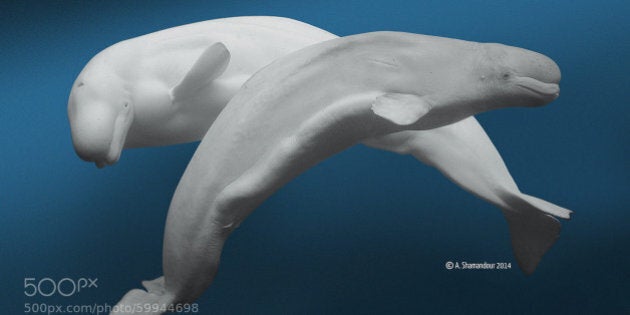
MONTRÉAL _ Depuis la fin de l'année 2014, 24 bélugas du Saint-Laurent ont été adoptés par des citoyens, des municipalités du Québec et des entreprises.
Ces adoptions symboliques ont été réalisées dans le cadre de la campagne "Adoptez un béluga" qui a été mise sur pied par le Groupe de recherche et d'éducation sur les mammifères marins (GREMM).
Mais ne devient pas "parrain" qui veut, puisqu'il faut débourser 5000 $ par année pour prendre sous son aile un de ces cétacés.
Le premier volet de la campagne avait été lancé en 1988 et avait permis de parrainer 122 bélugas. Le GREMM espère que ce deuxième volet verra 25 bélugas par année être pris en charge. La population de bélugas du Saint-Laurent compterait environ 900 individus.
En plus de financer la recherche sur les baleines blanches, la campagne a également pour objectif de sensibiliser la population au déclin de l'espèce.
De nombreuses villes, dont Montréal, Québec et Lévis, ont répondu à l'appel du GREMM.
Un groupe d'une quarantaine de municipalités riveraines du fleuve Saint-Laurent ont également adopté conjointement un groupe de 10 bélugas.
Elles ont par la suite demandé aux élèves d'une centaine d'écoles primaires de la province de baptiser leurs nouveaux protégés.
"En apprenant aux enfants à mieux connaître les bélugas, on se donne autant d'outils pour mieux les protéger", croit Robert Michaud, le président et directeur scientifique du GREMM.
Le groupe de recherche a ensuite envoyé aux écoles un bulletin rempli d'informations sur "leurs" bélugas pour poursuivre le travail de sensibilisation auprès des jeunes.
On y découvre ainsi que Pure Laine aime bien nager auprès de Bélibec, qu'Or blanc a une petite cicatrice près de la crête et qu'Écho apprécie se balader dans le fjord du Saguenay. Ces fiches d'information sont d'ailleurs disponibles sur le site internet de la campagne.
"On essaye d'expliquer que les bélugas vivent aussi dans une société assez complexe, que ce sont des animaux avec un mode de communication assez évolué", poursuit M. Michaud.
Les fonds recueillis par le GREMM permettent de financer des projets de recherche sur les bélugas qui sont menés par une dizaine de groupes de recherche universitaires et issus du secteur privé.
"Par exemple, une partie des fonds est utilisée pour récupérer et transporter des carcasses de bélugas et les amener à la faculté de médecine vétérinaire de l'Université de Montréal où sont réalisées des autopsies", explique M. Michaud.
À elle seule l'an dernier, la Ville de Montréal a donné 22 000 $
à la campagne. La métropole a ainsi offert 5000 $ pour parrainer son béluga et 17 000 $ pour le parrainage collectif de dix autres membres de l'espèce.
"On en est très reconnaissant", témoigne M. Michaud qui ajoute qu'il y a un impact réel sur les capacités de recherche du groupe.
"Si on veut faire des choix éclairés comme société on a besoin d'avoir de bonnes connaissances", explique-t-il.
Selon M. Michaud, la décision de TransCanada de revenir sur son choix de construire un port pétrolier à Cacouna pour son projet d'oléoduc Énergie Est en est la preuve.
"On a la conviction que c'est la science qui leur a fait entendre raison. Ils ont compris la valeur du secteur pour le bélugas", croit-il.


